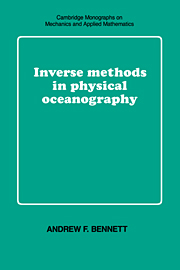Book contents
- Frontmatter
- Contents
- Preface
- 1 Finite-dimensional inverse theory
- 2 The smoothing of observations
- 3 Data assimilation
- 4 The spatial structure of the Kalman filter
- 5 Generalized inverses of dynamical models
- 6 Antenna analysis
- 7 Nonlinear quasi-geostrophic models
- 8 Open-ocean modelling: quasi-geostrophy
- 9 Primitive-equation models
- 10 Outstanding problems
- Bibliography
- Subject index
1 - Finite-dimensional inverse theory
Published online by Cambridge University Press: 08 January 2010
- Frontmatter
- Contents
- Preface
- 1 Finite-dimensional inverse theory
- 2 The smoothing of observations
- 3 Data assimilation
- 4 The spatial structure of the Kalman filter
- 5 Generalized inverses of dynamical models
- 6 Antenna analysis
- 7 Nonlinear quasi-geostrophic models
- 8 Open-ocean modelling: quasi-geostrophy
- 9 Primitive-equation models
- 10 Outstanding problems
- Bibliography
- Subject index
Summary
Introduction
This is an outline of some applications of finite-dimensional inverse theory to ocean modeling. The objective is ot to offer a comprehensive discussion of every application and its consequences; rather it is to introduce several concepts in a relatively simple setting:
an incomplete ocean model, based on physical laws but possessing multiple solutions;
measurements of quantities not included in the original model but related through additional physical laws;
inequality constraints on the model fields or the data;
prior estimates of errors in the physical laws and the data; and
analysis of the level of information in the system of physical laws, measurements and inequalities.
Much of this material is well covered in mathematical texts, geophysical monographs and scientific review articles. Thus the presentation is brief and directed towards subsequent application of these concepts in more complex settings. However actual oceanographic studies are discussed, and tutorial problems are posed.
The β-spira
A major objective of physical oceanography in the 1970's was the exploration of the dynamics of mesoscale eddies and their influence on large-scale ocean circulation (Robinson, 1983). It was therefore something of a surprise when, in 1977, Stommel & Schott showed that the vertical structure of large-scale horizontal velocity fields could be explained using simple equations expressing geostrophy and mass balance. A compelling aspect of their study was the use of data in order to complete and then test their calculations. The original paper (Stommel & Schott, 1977) is somewhat cryptic.
- Type
- Chapter
- Information
- Inverse Methods in Physical Oceanography , pp. 1 - 46Publisher: Cambridge University PressPrint publication year: 1992



